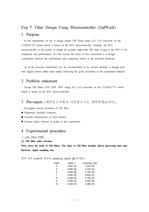

PLATINUM
PLATINUM 등급의 판매자 자료
[A+] RLC회로 Frequency domain 레포트
"[A+] RLC회로 Frequency domain 레포트"에 대한 내용입니다.
15 페이지
최초등록일 2023.11.08
최종저작일
2023.11
![[A+] RLC회로 Frequency domain 레포트](https://image4.happycampus.com/Production/thumb212/2023/11/08/data29157567-0001.jpg)
-
미리보기
소개
"[A+] RLC회로 Frequency domain 레포트"에 대한 내용입니다.목차
1. Title
2. Abstract
3. Table of contents
4. Introduction
1) Objective of Experiment
2) Basic Theory of Experiment
5. Method
1) Digital Multimeter
2) Function Generator and Oscilloscope
3) Bode Analyzer
6. Results
1) Digital Multimeter
2) Function Generator and Oscilloscope
3) Bode Analyzer
7. Discussion
1) Digital Multimeter
2) Function Generator and Oscilloscope
3) Bode Analyzer
8. Conclusion
9. Reference
10. Appendix본문내용
This experiment consisted of a total of 3 experiments. In the first experiment, three different resistors are measured using a digital multimeter, and these resistors are connected in series, parallel, and mixed to measure the resistance, and compared with the theoretical value of the resistance read in color code. Their average error was 0.15% to 0.46%, and it was confirmed that all exist within 1%, which is the tolerance of resistance. In the second experiment, change the waveform, frequency, peak to peak amplitude, DC Offset, Voltage, and Timebase values using a function generator and oscilloscope, and compare how each parameter affects the shape of the wave. It was analyzed by dividing it into 5 cases. In the third experiment, the resonance frequency and damping ratio of the RLC circuit were calculated using the Bode Analyzer, and the Gain-Frequency graph and Phase-Frequency graph were derived.참고자료
· '02_Experiments_manual.pdf' by Sungkyunkwan University, School of Mechanical Engineering태그
-
자료후기
Ai 리뷰자료의 품질이 높고, 전문적인 내용이 많아 과제에 바로 활용할 수 있었습니다. 지식판매자에게 감사드리며, 계속해서 좋은 자료 부탁드립니다! 감사합니다. -
자주묻는질문의 답변을 확인해 주세요

꼭 알아주세요
-
자료의 정보 및 내용의 진실성에 대하여 해피캠퍼스는 보증하지 않으며, 해당 정보 및 게시물 저작권과 기타 법적 책임은 자료 등록자에게 있습니다.
자료 및 게시물 내용의 불법적 이용, 무단 전재∙배포는 금지되어 있습니다.
저작권침해, 명예훼손 등 분쟁 요소 발견 시 고객센터의 저작권침해 신고센터를 이용해 주시기 바랍니다. -
해피캠퍼스는 구매자와 판매자 모두가 만족하는 서비스가 되도록 노력하고 있으며, 아래의 4가지 자료환불 조건을 꼭 확인해주시기 바랍니다.
파일오류 중복자료 저작권 없음 설명과 실제 내용 불일치 파일의 다운로드가 제대로 되지 않거나 파일형식에 맞는 프로그램으로 정상 작동하지 않는 경우 다른 자료와 70% 이상 내용이 일치하는 경우 (중복임을 확인할 수 있는 근거 필요함) 인터넷의 다른 사이트, 연구기관, 학교, 서적 등의 자료를 도용한 경우 자료의 설명과 실제 자료의 내용이 일치하지 않는 경우
찾으시던 자료가 아닌가요?
지금 보는 자료와 연관되어 있어요!
문서 초안을 생성해주는 EasyAI


